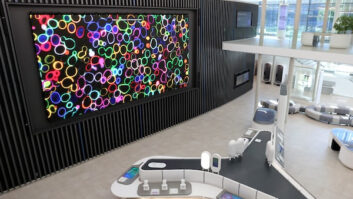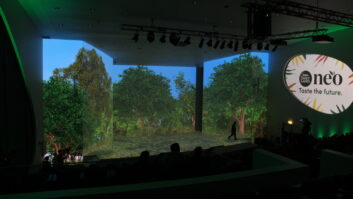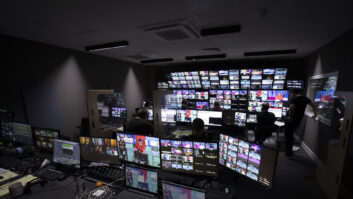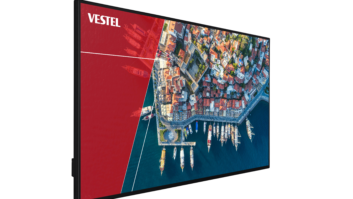
4K resolution is on its way; 4K resolution is here; 4K resolution is now dominant. The reality of the matter is somewhere between all of those. Ian McMurray talks to the industry to find out what’s really going on.
Some industry cynics claim that resolution is the primary weapon display manufacturers use to encourage us to buy new screens. Certainly, 3D didn’t do it for most of us. It’s a strategy that appears to work: according to Futuresource Consulting, we’ll be buying over 100 million 4K televisions per year by 2018. Economies of scale are already driving 4K pricing towards where 2K was only a year or so ago – so, inevitably, the AV industry has been sitting up and taking notice.
“Over the past year, we’ve seen a big change with manufacturers beginning to try to address 4K,” says Mark Armon, product manager at TV One. “In the past, no-one considered it a realistic want or need in the commercial AV space.”
Fast transition
“As expected, the transition to 4K in the professional AV sector is very fast,” notes Jeff Hastings, CEO of BrightSign. “BrightSign has shipped over 20,000 4K players in seven months. The industry has been able to move quickly as, unlike the consumer sector, it has control of the whole ecosystem – from content creation and distribution to presentation on the display.”
That’s bullish stuff. Chris Ault, reseller account manager at LG Electronics UK, is no less positive. “The demand for 4K has significantly increased,” he says. “A lot of education has taken place throughout the industry to show people how to make 4K accessible as a whole integrated solution, rather than just one element like the display.”
“Almost everyone ‘wants’ it,” adds James Ross Heron, AViary business development director at Green Hippo, developer of the Hippotizer media server and AViary video tools, “particularly the clients who want to write ‘…and all in stunning 4K resolution’ on the press release. We live in a world where the public can hold a tablet retina display in front of them playing high-resolution content of a quality which was no more than an aspiration for even professionals a few years ago. People expect a certain standard now.”
“We’re seeing our customers across many verticals buying 4K,” declares Tim Messegee, who is vice president, marketing at Prysm, “for collaboration, visualisation, real-time business management, command and control, and for venues where they want to make a strong visual impact such as lobbies and auditoriums.”
“It’s been no surprise that the number of displays featuring 4K resolution has increased,” says Brian Davies, AMX European technical director. “In fact, it is moving towards being a ‘no-cost’ option for many manufacturers in their professional ranges.”
So far, so good. It seems that everything in the 4K garden is rosy. But wait.
“Customers are demanding 4K/UHD for everything without understanding or considering whether they actually need it,” asserts Tim Brooksbank, chairman of Calibre. “The TV advertising by major Korean television brands has been so strong that nobody seems to consider the merits for or against: they just presume they must need it without considering what will actually be shown and how to get it to the display device.”
Doing the right thing?
He has an ally in Davies. “At least 90% of the people buying 4K now undoubtedly don’t need it,” he says, “but believe they are doing the right thing by installing 4K to be ‘future-proof’. Unfortunately for these customers, when it comes to signal distribution technology, not all solutions available today provide this. Technology-savvy customers are electing to hold off investing in 4K solutions until the market is able to demonstrate it can provide 2K flexibility in the distribution and switching of 4K60 signals.”
For current resolutions, “getting it to the display device” isn’t something anyone gives much thought to any more. 4K, it seems, presents challenges. Christopher Parker, senior product marketing manager, NEC Display Solutions Europe, takes up the story.
“The displays are basically there now,” he says, noting in particular the soon-to-be-launched PH1201QL projector which offers full 60Hz refresh at the native 4K resolution over quad SDI, “but the signal processing and connector chips have been more demanding in the development stages. This has introduced some unforeseen delays into the general 4K product line-ups. We’ve seen some interim or stop-gap dual-chip solutions from competitors, that have offered a quick fix, but these dual-chip solutions tend to be expensive and not so easy in the video signal handling or source configuration.”
“DisplayPort version 1.2 is also now established and offers very straightforward handling of 4K signals at 60Hz,” he continues. “However, the HDMI connector with version 2.0 has had to play catch-up, and chipsets are only now just starting to ship to display manufacturers.”
“Nonetheless,” he concludes, “the 4K infrastructure is falling into place, and is quickly becoming an established and mature portion of the market.”
HDMI 1.4 is limited to 8-bit colour at 30 frames per second with its 10.2Gb/s bandwidth. HDMI 2.0 will provide the 18Gb/s bandwidth required for 12-bit colour at 60 frames per second, and DisplayPort 1.2 will handle up to 21.6 Gb/s in its full four-lane implementation (and the DisplayPort 1.3 specification sees that increase to 32.4Gb/s) – at which point, distribution/cabling becomes the challenge.
“At this time, the infrastructure is still very limited,” says David Close, products and applications manager, EMEA at Digital Projection. “There is some capability for cabling and for high-end media servers and image generators. These are fine for specific applications such as visitor attractions and visualisation centres, but for general users such as corporate and lecture theatre who need to present various sources and need switching and so on, this aspect of the infrastructure is only just emerging.”
AMX by Harman
Brightsign digital signage solutions
Calibre 4K switching
More about Digital Projection
Green Hippo Hippotizer media servers and AViary Video Tools
For more on LG’s 4K products
NEC’s 4K product portfolio
Prysm 4K videowalls and Cascade collaboration
TV One processors







